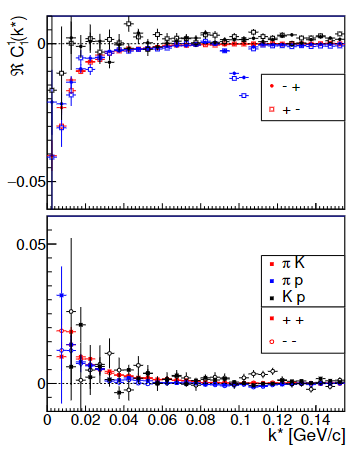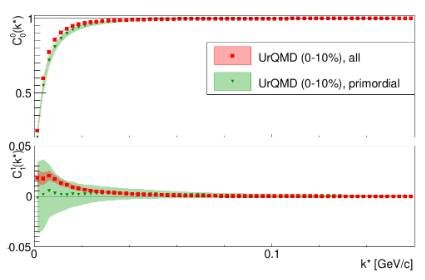Paper proposal: Non-identical particle femtoscopy measurements in the STAR Beam Energy Scan program
Title: Non-identical particle femtoscopy measurements in the STAR Beam Energy Scan program
Abstract:
Paper draft:
Analysis Note:
Presentation:
- paperProposalNonId_18.08.2022.pdf
- paperProposalNonIdSup_18.08.2022.pdf
- paperProposalNonId_PWGC_30.09.2022.pdf
Results (Proposed figures):
Figure 6
.png)
Figure 8
Figure 9
The purity of $\pi^+ K^+$, $\pi^+ p$, and $K^+ p$ pairs for Au+Au collisions at $\sqrt{s_{NN}} = 39$ GeV.
Figure 10
Impact of the momentum resolution on SH components.
Figure 11
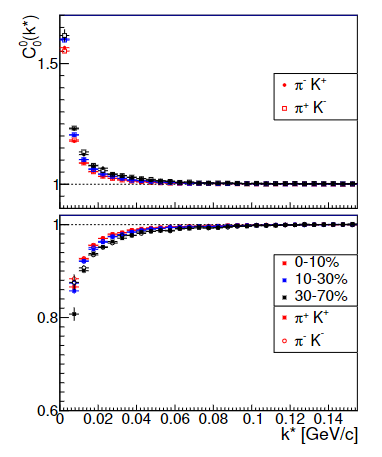
Comparison of $C_0^0 (k^*)$ SH components of like-sign (bottom) and unlike-sign (top) $\pi K$ pairs for Au+Au collisions at $\sqrt{s_{NN}} = 39$ GeV in different (0-10\%, 10-30\% and 30-70\%) centrality classes. Uncertainties are statistical only.
Figure 12

Figure 13
 Centrality dependence of $\pi K$ source size (R) for Au+Au collisions at $\sqrt{s_{NN}} = 39$ GeV. Statistic uncertainties are represented by solid lines. Shades show systematic ones.
Centrality dependence of $\pi K$ source size (R) for Au+Au collisions at $\sqrt{s_{NN}} = 39$ GeV. Statistic uncertainties are represented by solid lines. Shades show systematic ones.Figure 14
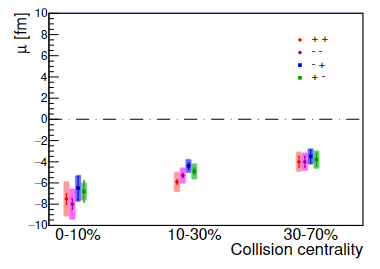
Centrality dependence of $\pi-K$ emission asymmetry ($\mu$) for Au+Au collisions at $\sqrt{s_{NN}} = 39$ GeV. Statistic uncertainties are represented by solid lines. Shades show systematic ones.
Figure 15

Comparison of $C_0^0 (k^*)$ SH components of like-sign (bottom) and unlike-sign (top) $\pi K$ pairs for central(0-10\%) Au+Au collisions at different energies $\sqrt{s_{NN}} = 7.7$, $11.5$ and $39$ GeV. Uncertainties are statistical only.
Figure 16
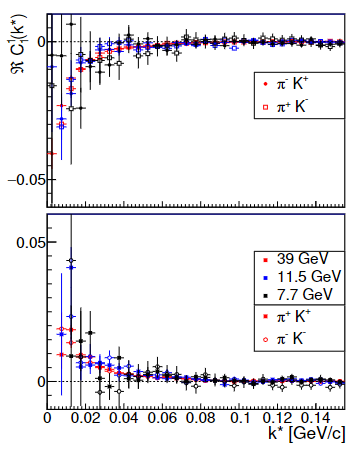
Comparison of $\Re C_1^1 (k^*)$ SH components of like-sign (bottom) and unlike-sign (top) $\pi K$ pairs for central(0-10\%) Au+Au collisions at different energies $\sqrt{s_{NN}} = 7.7$, $11.5$ and $39$ GeV. Uncertainties are statistical only.
Figure 17

Figure 18

Energy dependence of $\pi K$ emission asymmetry ($\mu$) for 0-10\% most central Au+Au collisions at $\sqrt{s_{NN}} = 7.7$, $11.5$ and $39$~GeV. Statistic uncertainties are represented by solid lines. Shades show systematic ones.
Figure 19

Comparison of $C_0^0 (k^*)$ SH components of like-sign (bottom) and unlike-sign (top) for $\pi K$, $\pi p$ and $Kp$ pairs for central (0-10\%) Au+Au collisions at $\sqrt{s_{NN}} = 39$ GeV. Uncertainties are statistical only.
Figure 20
Comparison of $\Re C_1^1 (k^*)$ SH components of like-sign (bottom) and unlike-sign (top) for $\pi K$, $\pi p$ and $Kp$ pairs for central (0-10\%) Au+Au collisions at $\sqrt{s_{NN}} = 39$ GeV. Uncertainties are statistical only.
Figure 21

Mean pair transverse mass dependence of source size for central (0-10\%) Au+Au collisions at $\sqrt{s_{NN}} = 39$ GeV for different charge combinations of $\pi K$, $\pi p$, and $Kp$ pairs.
Figure 22
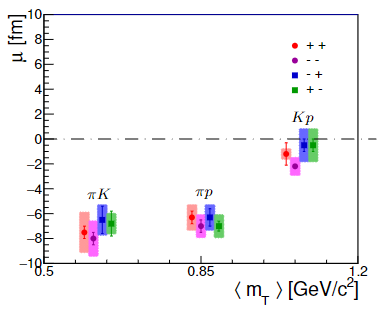
Mean pair transverse mass dependence of emission asymmetry for central (0-10\%) Au+Au collisions at $\sqrt{s_{NN}} = 39$ GeV for different charge combinations of $\pi K$, $\pi p$, and $Kp$ pairs.
Figure 23

Comparison of the relation between emission asymmetry of $\pi K$, $\pi p$, and $K p$ pairs for different charge combinations for central (0-10\%) Au+Au collisions at $\sqrt{s_{NN}}$ = 39 GeV.
Figure 24

Model (Therminator 2 and UrQMD) predictions for $\pi^+K^+$ correlation functions. UrQMD and experimental functions correspond to 0-10\% and Therminator 2 to 0-5\% central Au+Au collisions at $\sqrt{s_{NN}}$= 39 GeV.
Figure 25
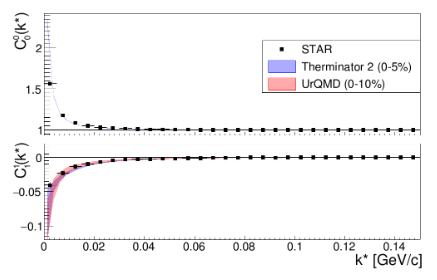 Model (Therminator 2 and UrQMD) predictions for $\pi^-K^+$ correlation functions. UrQMD and experimental functions correspond to 0-10\% and Therminator 2 to 0-5\% central Au+Au collisions at $\sqrt{s_{NN}}$= 39 GeV.
Model (Therminator 2 and UrQMD) predictions for $\pi^-K^+$ correlation functions. UrQMD and experimental functions correspond to 0-10\% and Therminator 2 to 0-5\% central Au+Au collisions at $\sqrt{s_{NN}}$= 39 GeV.
Figure 26
Figure 27
Conclusions:
- Results indicate that the average space-time positions of pions and kaons (and also pions and protons) are not the same for Au+Au collisions at 7.7, 11.5, and 39 GeV.
- Very small asymmetry is present in the case of kaon-proton pairs.
- Measured asymmetry satisfies the predicted relationship:

- Values of source parameters are consistent for all charge combinations.
- Spherical harmonics components are well described using 3-dimensional Gauss distribution as the source function.
- Strong interaction between kaons and protons needs investigation.
Previous presentations:
- New p/\bar{p} identification cuts
- New \pi^\pm, K^\pm identification cuts
- Background correction
- Momentum resolution:
- Parameters & fits (DR)
Bibliography:
- pawszy's blog
- Login or register to post comments

